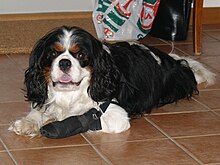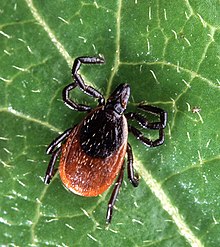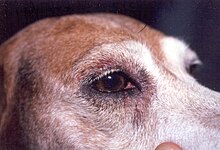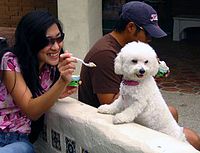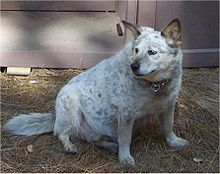Dog health
In dogs, transmission most commonly occurs by drinking puddle, pond, or ditch water contaminated by urine from infected wildlife such as squirrels or raccoons.
Signs include weight loss, cough, fever, enlarged lymph nodes, draining skin lesions, eye inflammation with discharge, blindness, and lameness.
In the United States it is mainly found in the Mississippi and Ohio River areas, most commonly in bird and bat feces.
[11] Coccidioidomycosis, caused by Coccidioides immitis, is found in arid and semi-arid regions of Central and South America, Mexico, and southwestern United States.
[17] In some dogs, such as collies, the blue merle or harlequin coloring is actually the heterozygote of a partially recessive gene preventing proper development of the nervous system; therefore, if two such dogs are mated, on the average one quarter of the puppies will have severe genetic defects in their nervous systems and sensory organs ranging from deafness to fatal flaws.
Panosteitis occurs in large and giant breed dogs usually between the age of five and fourteen months and manifests as fever, pain, and shifting leg lameness.
Hypertrophic osteodystrophy is also seen in young large and giant breed dogs and is characterized by pain, lameness, fever, and swelling of the long bone metaphysis.
[20] Scottish terriers have eighteen times the risk of mixed breed dogs to develop transitional cell carcinoma, a type of urinary bladder cancer.
Signs of vestibular disease include head tilt, circling, nystagmus (an abnormal movement of the eyes), and difficulty or inability to stand.
The major risk with idiopathic peripheral vestibular disease is that the dog is often unable to eat, drink, or go outside to urinate or defecate.
These cases must receive supportive therapy of intravenous fluids and nutrition; a light sedative is sometimes administered, as the dog may be very stressed by the experience.
Older, small breeds of dogs are prone to congestive heart failure due to degeneration of the mitral valve.
Decreased output of blood by the left ventricle causes the body to compensate by increasing sympathetic tone and activating the renin–angiotensin–aldosterone system (RAAS).
Treatment for congestive heart failure has historically focussed on two types of drugs that address these concerns: diuretics (especially furosemide), which decrease blood volume, and ACE inhibitors, which interrupt the RAAS.
A major veterinary study, called the QUEST study (QUality of life and Extension of Survival Time), published in September 2008 found that dogs with congestive heart failure receiving pimobendan plus furosemide had significantly better survival outcomes than those receiving benazepril (an ACE inhibitor) plus furosemide.
[32] In 2018, the U.S. Food and Drug Administration (FDA) issued a report citing a possible link between certain diets and canine dilated cardiomyopathy (DCM) in dog breeds without the genetic predisposition.
Researchers at University of California, Davis School of Veterinary Medicine announced the results of their own study in early 2019, confirming the connection and identifying a particular concentration found among Golden Retrievers.
Diet-related DCM is associated with grain-free and/or legume-rich diets, as well as "boutique" dog foods containing exotic ingredients (such as bison or kangaroo meat).
Common reproductive diseases include pyometra (distension of the uterus with pus), mammary tumors, and benign prostatic hyperplasia.
Some common sources of toxins that pets encounter include some plants,[33] human medications and cosmetics,[34] cleaning products,[34] and even some foods.
[35] Some foods consumed safely by humans are harmful to dogs: Cocoa within chocolate contains theobromine,[36] a chemical stimulant that, together with caffeine and theophylline, belongs to the group of methylxanthine alkaloids.
[38] In case of accidental intake of chocolate, especially involving a smaller dog, contact a veterinarian or animal poison control immediately; it is commonly recommended to induce vomiting within two hours of ingestion.
These chemicals are responsible for their signature spicyness, but also causes oxidative damage to red blood cells of dogs and cats.
[38] Avocado leaves, bark, skin, and pit are known to be harmful to a wide range of animals, including dogs and cats.
Aspirin, paracetamol/acetaminophen (Tylenol), ibuprofen (Advil), and naproxen (Aleve) can all cause severe clinical signs in dogs, including vomiting blood, diarrhea, and abdominal pain.
Treatment depends on the clinical signs and often involves inducing vomiting, gastric lavage, intravenous fluid diuresis, and supportive care.
The specific vaccinations recommended for dogs varies depending on geographic location, environment, travel history, and the activities the animal frequently engages in.
Just as in humans, a dog's diet must consist of the appropriate mix of nutrients, carbohydrates, and proteins to give them the minerals and vitamins that they need.
[73] Animal control agencies in the United States and the ASPCA advise that dogs not intended for further breeding should be spayed or neutered so that they do not have undesired puppies.
[74] Because of the overpopulation of dogs in some countries, puppies born to strays or as the result of accidental breedings often end up being killed in animal shelters.
